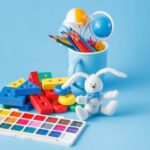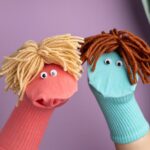Children Develop By Playing With Toys
Accompany your child and you will find that even a simple toy can open up a world of learning for your child while changing differences and skill delays. Playing is a natural way for children to explore, learn and grow, shaping their cognitive, social, motor and language skills. Toys are not just entertainment, but also powerful tools that can target specific areas of development. Want your child to have normal skills or develop specific skills? Are you curious, questioning and confused?
Here we delve into how toys can develop basic skills, with a special focus on speech pathology toys that support language development. We will give you specific examples of toy categories that can enhance social skills, cognitive development and hand-eye coordination, so that you can have a clearer and more discerning understanding; and provide practical advice and product recommendations to help parents and caregivers make wise choices.
Toys for Social Skills: Building Connections Through Play
What Are Social Skills and Why Do They Matter?
Social skills, such as sharing, turn-taking, and understanding emotions, are the foundation of healthy relationships. These skills help children interact with peers and adults, navigate social situations, and develop empathy. According to experts, toys that encourage cooperative or imaginative play are particularly effective in fostering social-emotional intelligence.
Top Toys for Social Development
Several toy categories promote social skills by encouraging interaction and collaboration:
- Board Games: Games like Candy Land or Chutes and Ladders teach turn-taking and cooperation. Children learn to follow rules and engage with others in a structured setting.
- Pretend Play Sets: Kitchen sets, doctor kits, or dollhouses inspire role-playing, helping kids practice communication and empathy. For example, playing “restaurant” encourages children to use language to order food or serve customers.
- Dolls and Stuffed Animals: These toys allow children to act out scenarios, fostering emotional expression and social understanding.
How to Use These Toys
To maximize social skill development, play alongside your child. For instance, during a board game, model phrases like “Your turn!” or “Great job!” to encourage communication. Pretend play sets can be used to act out real-life scenarios, such as visiting a doctor, which helps children learn social cues and appropriate responses.
Toys for Cognitive Development: Sparking Young Minds
Understanding Cognitive Development
Cognitive development involves skills like problem-solving, memory, and critical thinking, which are essential for academic success and everyday decision-making. Toys that challenge children to think creatively or solve problems can significantly boost these abilities.
Best Toys for Cognitive Growth
Here are some toy categories that support cognitive development:
- Puzzles: Simple puzzles for younger children or more complex ones for older kids enhance problem-solving and spatial awareness.
- Building Blocks: Sets like LEGO DUPLO or Melissa & Doug Wooden Building Blocks encourage creativity and logical thinking as children construct structures.
- Educational Games: Games that involve matching, counting, or memory exercises, such as Memory or Counting Bears, stimulate cognitive skills.
Practical Tips for Parents
Encourage open-ended play with building blocks by asking questions like, “What are you building?” or “Can you make it taller?” For puzzles, start with simpler designs and gradually increase complexity to build confidence and problem-solving skills.
Best Toys for Speech Therapy: Unlocking Communication
What Is Speech Therapy?
Speech therapy helps children with speech delays, articulation issues, or conditions like autism improve their communication skills. Toys are a cornerstone of play-based speech therapy, making sessions fun and engaging while targeting expressive and receptive language skills.
Toys Good for Speech Therapy
Speech pathology toys are designed to encourage verbalization, vocabulary growth, and social interaction. Here are some effective options:
- Bubbles: Bubbles are a favorite for teaching cause-and-effect and encouraging words like “pop,” “more,” or “bubble.” They’re especially effective for toddlers with short attention spans.
- Play-Doh: This versatile toy allows children to describe actions (e.g., “roll,” “cut”) and colors, fostering expressive language.
- Farm Sets: Toy farms, like the Fisher-Price Little People Caring for Animals Farm, help children learn animal names, sounds, and prepositions like “in” or “on.”
- Mr. Potato Head: This classic toy teaches body parts and following directions, such as “Put on the eyes.”
- Interactive Books: Books with flaps or textures, like Poke a Dot Books, engage children in reading and pointing, promoting language development.

Cause-and-Effect Toys for Speech Therapy
Cause-and-effect toys help children understand that their actions produce results, which can encourage verbalization. Examples include:
- Spinning Drum: A toy like the VTech Spinning Drum responds to a child’s touch with movement or sound, prompting words like “spin” or “go.”
- Pop-Up Toys: Toys like Playskool Pop N Pals encourage children to press buttons or turn knobs, eliciting exclamations like “pop!” or “up!”

These toys are particularly effective for children in the 9- to 12-month developmental range, as they learn to associate actions with outcomes (Teach Me To Talk).
Toys for Language Development
Toys that encourage imaginative play or storytelling are excellent for language development:
- Dolls and Action Figures: These toys allow children to create narratives, practicing sentence formation and social language.
- Play Scenes: Sets like toy kitchens or garages encourage children to describe actions and objects, expanding their vocabulary.
- Interactive Books: Books with audio features or interactive elements help children learn new words and practice pronunciation.
Product Recommendations
Here are two highly recommended speech pathology toys:
- No-Spill Bubble Tumbler: This toy is perfect for toddlers, encouraging requests like “more bubbles” while teaching cause-and-effect through blowing and popping.
- Fisher-Price Little People Caring for Animals Farm: This farm set promotes imaginative play and vocabulary growth by introducing animal names, sounds, and prepositions.
How to Use Speech Therapy Toys
Parents can enhance speech therapy by modeling language during play. For example, with bubbles, say “Blow!” or “Pop!” and pause to encourage your child to repeat. With farm sets, name animals and make their sounds, asking questions like, “Where’s the cow?” to prompt responses. Consistency and engagement are key to reinforcing language skills at home.
Toys for Hand-Eye Coordination: Building Motor Skills
The Importance of Hand-Eye Coordination
Hand-eye coordination is critical for tasks like writing, drawing, and sports. It involves the ability to synchronize visual input with hand movements, a skill that develops over time and can be supported through play.
Age-Appropriate Hand Coordination Toys
Different toys suit different developmental stages:
| Age Group | Recommended Toys | Benefits |
|---|---|---|
| Infants (0-12 months) | Rattles, activity gyms, soft balls | Encourage reaching and grasping, stimulating early motor skills |
| Toddlers (1-3 years) | Stacking rings, shape sorters, simple puzzles | Develop fine motor control and hand-eye coordination |
| Preschoolers (3-5 years) | Building blocks, threading beads, simple sports equipment | Enhance precision and coordination through construction and active play |
| School-Age (5+ years) | Complex puzzles, sports equipment, video games | Improve reaction time and advanced motor skills |
Product Recommendation
- Melissa & Doug Wooden Stacking Train: This toy encourages toddlers to stack colorful blocks on a train, promoting hand-eye coordination and color recognition.
When it comes to hand-eye coordination training or cerebellum development, I recommend you play with fidget spinners.Kids can exercise hand movement, eye observation, cerebellum thinking and three-dimensional spatial imagination by twisting, spinning, observing and touching. This is a versatile toy! Shop for concentration and learning tools for children and adults of all ages. Maybe you are interested in this toy, Tangle Creations is the birthplace of fidget spinners! A variety of popular colors and textures to choose from! Designed to inspire peace through creativity, you can play, collect, and have endless fun!
Tips for Parents
Start with simple toys like stacking rings for younger children and gradually introduce more complex tasks, such as threading beads or playing catch, as they grow. Encourage practice by praising effort and celebrating small successes.
The Purpose of Toys in Skill Development
How Toys Impact Child Development
Toys serve as tools for learning across multiple domains:
- Cognitive Development: Puzzles and building blocks foster problem-solving and creativity.
- Motor Development: Hand coordination toys like shape sorters and sports equipment enhance fine and gross motor skills.
- Social Development: Cooperative games and pretend play sets teach communication and empathy.
- Language Development: Speech pathology toys like interactive books and farm sets expand vocabulary and encourage verbalization.
By offering a variety of toy categories, parents can create a rich environment that nurtures a child’s overall development. Play is a natural and enjoyable way for children to learn, making it an ideal method for skill-building.
Choosing the Right Toys
When selecting toys, consider:
- Age Appropriateness: Ensure the toy matches your child’s developmental stage.
- Safety: Check for non-toxic materials and no small parts for younger children.
- Engagement: Choose toys that align with your child’s interests to maintain their attention.
- Skill Focus: Select toys that target specific skills, such as speech or motor development.
Consulting with a speech therapist or pediatrician can provide tailored recommendations, especially for children with developmental delays.
Ability Development – Playing With Toys With A Purpose
From the perspective of skill-specific toys, toys are not just a plaything, but a foundation for children to learn and grow. By choosing toys that are appropriate for the development of different skills and coordination at different ages, parents can support their children’s social, cognitive, motor and language development. Speech and coordination toys, in particular, can help children with language delays communicate confidently in a fun and effective way.
Whether it’s blowing bubbles to encourage speaking or building blocks to help improve coordination, the right toys can have a lasting impact. Are you curious about whether it’s really as the arguments and research say, you are welcome to actively explore these toys, then discover and feel, try our recommendations, and watch your child continue to progress in the joy of playing, and skills will flourish.


